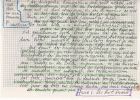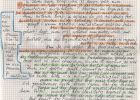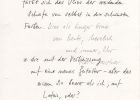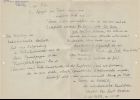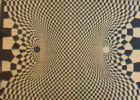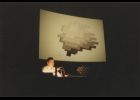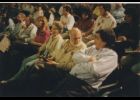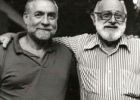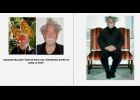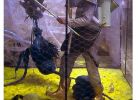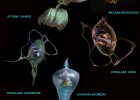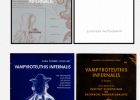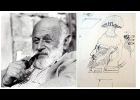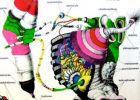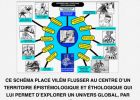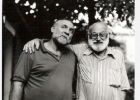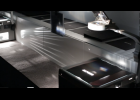On Flusser’s Struggle with Nihilism
Flusser’s work has been the object of various one-sided and selective interpretations. However, overcoming bottomlessness is at the core of his life’s work. He resorted to strategies like play, dialogue, contemplation, celebration, ritual, translation, and culture but knew they did not solve the problem of the absurd human condition, of being sentenced to death and oblivion. Flusser was aware of this contradiction; the freedom he achieved beyond bottomlessness was a desperate one. Bottomlessness is a prerequisite for freedom, but its repression is necessary for survival. Instead of choosing either suicide or orthopraxis, Flusser saw human communication, dialogue, “as a means to create meaning and as a method for the survival in the Other”.
Letters / From a Universe in Colors toward a Color Universe
The letter exchange between Vilém Flusser and Philippe Henry covers a period of about two-years, from July 1987 to November 1989 and deals mainly with the organization of the project of the House of Colour in São Paulo. Henry and his wife visited Flusser in Robion and met Edith and Vilém Flusser on several occasions in Brazil. The letters were accompanied by texts related to the project, both by Flusser and Henry, who considered Flusser a teacher and a source of inspiration. In “From a Universe in Colors toward a Color Universe”, Henry discusses different understandings of colour, from Newton’s prism to modern biology, and how our understanding of colour has shifted.
Letters / Farben statt Formen / Coloration replacing formalisation / Farben verschlüsseln / Karl Gerstner / Vilém Flusser und die Farben
Vilém Flusser and Karl Gerstner got to know each other in February 1987 at the 2nd Latin American Seminar on Alternatives for the teaching of the history of science and technology. Their letter exchange covers a period of about two years (1987-1989). Flusser and Gerstner were united by an intellectual and emotional friendship, read each other’s works, and dedicated a very personal text to one another: “Karl Gerstner” and “Vilém Flusser und die Farben” published in 1992 after Flusser‘s death. Flusser wrote two other texts “Farben verschlüsseln“ and “Farben statt Formen“, together with its English version „Coloration replacing formalisation“ in early 1988, as a discussion proposal for Gerstner. He dedicated “Farben verschlüsseln“ to Gerstner and sent the text with a letter, dated March 4, 1988. While Flusser wrote all his texts with a typewriter, Gerstner’s letters are practically all handwritten and in some cases in colour. To emphasize this difference the letters have been published separately and in different formats: Flusser’s letters are PDF-files and Gerstner’s JPEG and JPG-files.
Colorarium: The Exchange of Letters between Vilém Flusser, Karl Gerstner, Philippe Henry and Gottfried Jäger
This essay is about the relationship and collaboration between Vilém Flusser, Karl Gerstner, Philippe Henry, and Gottfried Jäger and the way this impacted the project of the House of Colour in São Paulo between 1987 and 1989. In this period, Flusser exchanged numerous letters and texts with his three correspondents, continuously re-elaborating and expanding his ideas about colour and their specific role in the project. This communication process was naturally enough multilingual. Flusser used English, German and Portuguese interspersed with French. Jäger wrote his texts in German, Gerstner in German and English, and Henry used Portuguese and French. The plurality of idioms is echoed in the use of different media. Besides forms of written communication (letters, essays, telegrams), video interviews were done in Robion, which were viewed and commented upon in Brazil. Henry conveyed the questions by phone and Flusser reacted in written form. Gerstner and Flusser wrote several texts together. Flusser travelled three times to Brazil, visited Gerstner in Basel and Hippoltskirch and Jäger in Bielefeld. Both Gerstner and Jäger came to see him in Robion. Henry travelled several times to Robion, and also met Gerstner and Jäger. All this ensured a constant flow of back-and-forth information within the small network of friends.
Communicology and Education. Possibilities for intersubjective experiences of knowledge
This paper positions Vilém Flusser’s pedagogical propositions in relation to his concept of communication, which in turn is based on his diagnosis of the ethical, aesthetic, and epistemological transformations currently being imposed on societies. The study starts from Flusser's understanding that cultural models are going through a crisis. The core of this crisis lies in uncertainty concerning the consolidation of behaviours, experiences, and knowledge, an uncertainty readily observed in educational structures. Education, a subject not often explored in Flusserian thought, is understood here as ideologically planned communication for social functioning. This understanding is defended here as supporting the construction of more conscious and engaged new knowledge under the crisis conditions Flusser described. Because it resists both objectivation and subjectification of thought, intersubjectivity becomes a goal of education, a potential means of creating dialogic environments.
Interview
In this interview, Fred Forest, Jean-Louis Poitevin and Martial Verdier, discuss the relationship between Fred Forest and Vilém Flusser, their collaboration over the years and the influence they had on each other’s work and thinking. Verdier was at one time Forest’s assistant; he is now Secrétaire Général of TK21 and has recorded and edited the discussion. The interview begins with their first meeting between Forest and Flusser and the person of Flusser himself. It then moves on to a major field of collaboration: gestures (ca. 4.38) and the role of dialogue and intersubjectivity (ca. 5.55). They also discuss the notion of apparatus (ca. 9.00), video (ca. 17.25) and the group “Art Scociologique” (ca. 20.25 and again ca. 37.40). Forest talks about the dissolution of the group and about one of his members Hervé Fischer (ca. 38.30) (see the interview with Fischer in this issue). Verdier questions Forest about Flusser’s impact on his work and the way he himself influenced Flusser’s thinking (ca. 29.30). The very last question concerns the future of art. The situation today, Forest says, is tragic, but there is also hope for “a return to more honest, profound and valuable” things.
Password: Flusser
En hommage à Louis Bec (1936-2018)
Louis Bec, who died three years ago, was one of Flusser’s closest friends, one of the few with whom he never quarreled, and the only one with whom he co-authored a book. They met every Saturday to exchange their ideas. This essay discusses Bec’s life, his creation of the “Institut Scientifique de Recherche Paranaturaliste”, his work as a “zoosytematician” and his theories about bio-art and artificial life, some of his artistic installations, such as the Sulfanogrades, as well as their most important project, the Vampyroteuthis infernalis. Their friendly and intellectual complicity lasted seventeen years: it is difficult to imagine what Flusser would have been without Bec, or Bec without Flusser.
Vampyroteuthis Infernalis, le podcast comme format de recherche-création
For this special issue of Flusser Studies on Vilém Flusser's relations with France, I would like to propose a research-creation format, which is embodied in a podcast that is part of the Bio Is The New Black series. The podcast is a creation based on reading the Vampyroteuthis Infernalis and research conducted at the Vilém Flusser Archive in Berlin under the supervision of Anita Jóri. Bio Is The New Black is a podcast around design, biology and technology that invites artists, designers, philosophers, scientists and engineers to explore the multiple ethical, critical and creative questions that arise with bio-manufacturing technologies.
The Anti-Archive as a spatial design tool for the continuous destruction and reconstruction of memory
The installation Anti-Archive in the Vilém Flusser Archive (Berlin) establishes a design posture, a method for conveying content from memory spaces that rejects the reproduction of historical discourses. Instead, it seeks to show the ruptures and gaps in history in which each individual can endlessly reconstruct his memory. There are infinite anti-archives in every archive.
Rethinking Interology with Flusser
Motivated as much by a deep concern with the rapidly evolving human condition as by intellectual curiosity, this article reveals the problem-driven and futurological nature of Flusserian interology [Deleuze]. It proposes that compared to traditional ontology, the notion of interality and the dynamics of interology offer us a more adequate way of thinking through our situation in the here and now and in the immediate future. The secondary motive is to turn Flusser’s media philosophy into a pointillist verbal art, a techno-ethics, and an intertopia befitting the digital era.

